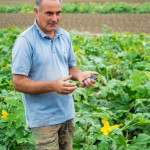Farm description
The Caramadre farm is located in the Agro Romano, within the National Reserve of the Coast and near the Macchia Grande Reserve of the WWF Natural Oasis. It includes two different areas:one area is located in Maccarese (7.5 hectares wide including 2 hectare of cold greenhouses) and it is the place of the wholesale and retail sale of the the farms fruits and vegetables;The second areais in Torre in Pietra (13 hectares wide) and it consists of all organically cultivated fields. On the basis of the season, here, crops of several fruits and vegetables (such as broccoli, cabbage, cauliflower, cabbage, summer melons, strawberries, salads, beets, etc) are planted.
The farm is located in Rome peri-urban area. This allows the farmer to sell his production by short food chain in different farmer markets of the city. For this reason, the main crops are in autumn and winter with intensive crop cycle and a high crop diversification. Tomato and zucchini are produced in greenhouse. The soil is sandy, with some clay in it and a presence of organic matter around 2%.
According to the farmer Claudio Caramadre, the implementation of the organic farming methods means not making use of both GMOs (Genetically Modified Organisms) and any chemically synthesized product; using only natural fertilizers (manure, minerals, compost) with no environmental impact; reducing drastically the field manipulation by means of the working only of the field surface in order to prevent the soil and the aquifers impoverishment.
To learn more, please visit the farm’s website http://www.biocaramadre.it/
Climate-friendly practices applied
1. Improved on-farm nutrient management
2. Optimized crop rotations with legumes
Introducing forage and grain legumes
Before the SOLMACC project, the farmer did not include forage legumes into his crop rotation management. This was identified as the main concern by the advisory team. The main reason for the farmer to exclude forage legumes was the lack of market demand in urban areas.In terms of cash crops, the only legume is fava bean. The farmer is testing the use of sudan grass as a green manure. This technical solution do not have an economic feasibility according to the farmer, due to his market requirement for production in the winter time. Different options have been proposed by the advisory team to introduce a mix of legumes for green manure: a mix of legumes, the use of a mix of legumes associated with a sole legume crop (40/60%); and finally the combination of three legumes with a percentage of 35/15/50%.
3. Optimized tillage management systems
Reduced depth of tillage
Before the project, the farmer ploughed all of his crop cultures. Now, he reduced the depth of tillage for all crops, by only working superficial (with a depth of 0-10 cm).
By employing these practices diesel consumption will be reduced.
4. Agroforestry
Boundary trees on agricultural fields
Pine and eucalyptus trees, typical of the area, border the vegetable production. Their main role is to protect the crops from the wind. The trees help to sequester atmospheric carbon into plant biomass and soils. Therefore, they function as a carbon sink.
Special credit goes to Klaus-Peter Wilbois for the photographs published in this page.
Location
Other farms
